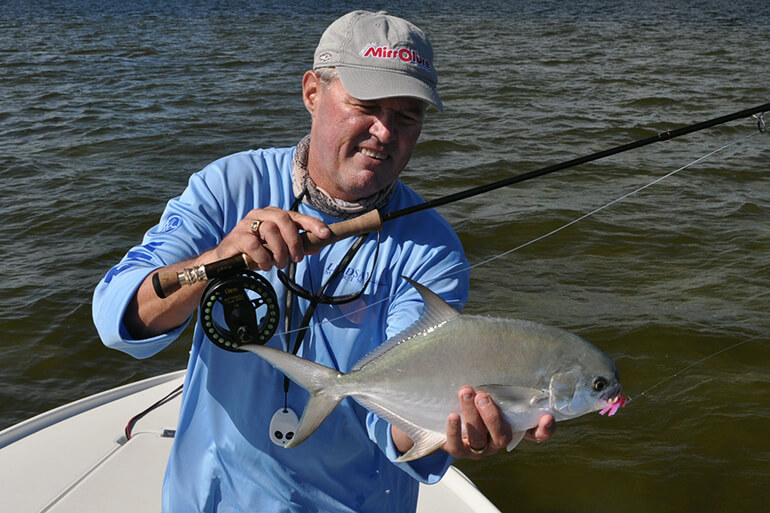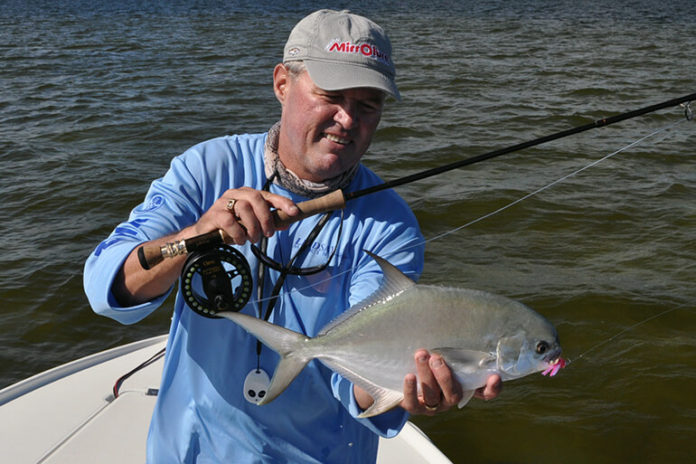Tips on fishing weighted flies down deep.
When catching a particular fish calls for getting the fly down deep, there are some basic solutions you can add to your fly fishing practice to achieve this.
When catching a particular fish, or more fish, calls for getting the fly down deep, there are three basic solutions: Secure some form of weight into the fly while tying. Add some weight right on the spot. Fish a sinking line.
I use all three methods, with consideration to circumstances and some practical matters. For example, I choose the lightest dumbbell lead eye or the least amount of lead wire possible to get the fly to the level in the water I desire, without making casting too tough. Truth is, I would rather fish a sinking line with a weightless or slightly weighted fly than fish a floating line with a weighted “bomb,” but there are ways to balance things out.
EYE CHOICE

Pompano fly tied by author is shown with examples of dumbbell eyes in various configurations, plus spool of soft lead wire.
Bead chain eyes in size small to medium are great for skinny water, when bonefishing or redfishing for example. They come in silver, gold and black. The x-small or small lead eyes are better for cruising fish in 2 to 3 feet.
The heaviest lead dumbbell eyes force you to fish a heavier rod, perhaps heavier than you’d like. For example, I’m often fishing pompano in water 5 to 8 feet deep, with tidal current. Here I would prefer to fish a fly with the lightest lead eye possible, with a sinking line. This allows me to fish a 7- or 8-weight rod rather than the 9-weight which would be needed to handle a big lead eye fly. In short, I prefer to have my weight in the line rather than in the fly.
LINES AND CASTING WITH WEIGHTED FLIES

From left to right: Clear intermediate, medium sink and fast rate sinking lines.
With a full floating line, a fly can only sink as fast as the leader allows it, before being held up by the tip of the line. It is counter-productive if fish are more than 4 feet deep, and if there is much current (especially running perpendicular to your position), the floater gets a belly in it, and things become a mess. At most, I will fish a fly with a size small or extra-small lead eye. There seems to be a hinging effect with floating lines and heavy flies, too, because the floater forced you to fish a longer leader.
A clear intermediate line may be the most useful with weighted flies. It sinks enough to help the fly sink, and it will keep the fly down there when you strip it. And, this setup allows you to fish a very short leader, perhaps 5 feet long. The densest sinking lines will sink at 5 to 6 inches per second. Great for deeper water and also allow for a short leader. You can get away with weightless flies in this case or at most, the smallest lead eyes.

Author with pompano.
Whichever line and fly you cast, remember to open up your loop a bit, and avoid quick stops on the backcast. The open loop will prevent the weighted fly from crashing into the rest of the line, or your rod tip, on the forecast.
Should you be caught with strictly unweighted, buoyant flies in your box and the fish are staying deep, try this neat trick I learned long ago: Carry a spool of soft lead fly-tying wire in your fly box. Just a few wraps of the stuff under the fly wing on the hook shank sinks it much faster. I used the trick a few years ago in Louisiana when giant reds were swimming a couple of feet under the surface. The water was muddy so we could not spot them until just off the bow. I wrapped the lead wire at the nose of my streamers and it paid off. We could “bean” the fish and get the fly down quickly where the fish could see it. FS
Florida Sportsman Magazine March 2020

The intermediate sinking line is my go-to for over half of the fishing I do. Floating seagrass can foul your fly, or surf swells can ruin your presentation…

Stealthy hunts, visual fishing and great fights are what we enjoy, right? Pompano on their annual migration offer great opportunities for fly fishermen….
Credit: Source link































